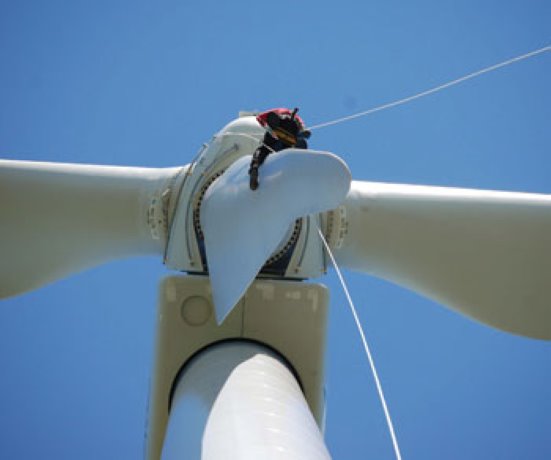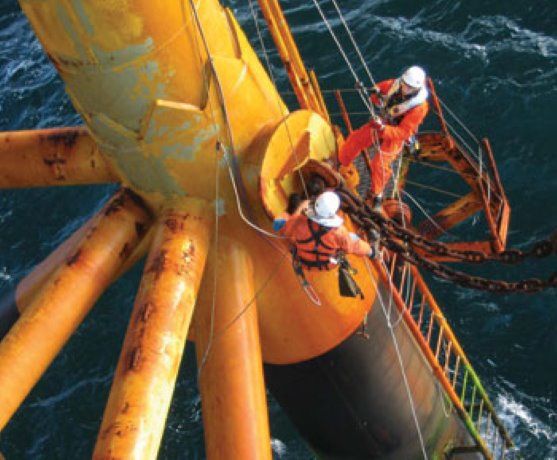A growing demand for skilled trades, such as electricians and welders, to be schooled in the skills of rope access has led to the opening of a training academy.
Amateur daredevils will pay $175 to walk around the outside edge of the CN Tower’s revolving restaurant, secured only by a harness and a rope.
Igor Stomp gets paid $175 an hour to do the same thing. But, for Stomp it’s not scary, it’s his job.
“It’s more dangerous driving to the job site than it is dangling 125 storeys above the ground,” he said.
For years, he has been hired to paint the fibreglass cladding at the very top of the 553.3-metre-high tower, 220 metres above the restaurant level.
Starting in August, visitors to the CN Tower will have the option of taking a 20-minute, hands-free walk around the outside rim of the revolving restaurant, which is 346 metres above the ground.
They’ll wear a harness and be connected by rope to a security cable.
For more than 20 years Stomp, an engineer, has been hanging off high structures to reach normally inaccessible spots.
And now students come from around the world to attend his school in Fergus, a small town north of Guelph, to learn how to survive at the end of a rope.
Most of his students are construction trades, but some pupils are soldiers, police officers, search-and-rescue squads, firefighters, military cadets and mountain climbers.
“We are not looking for mountain climbers to teach them how to be electricians, welders, and such,” said Stomp.
“We train electricians, welders, carpenters and other trades how to safely get to their hard-to-reach work stations by rope.”
With thousands of towering wind generators being erected throughout the countryside, there has been an equally booming demand for qualified construction workers to erect, maintain and repair those windmills, many of them 90 metres high.
“It helps if they’re not afflicted with a paralyzing fear of heights,” added Stomp.
Some of the training at Stomp’s school happens close to the ground — at desks where they learn how to tie a knot in a rope, how to lace a rope through a pulley, as well as construction safety legislation. But, for much of their training the students are suspended by ropes and harness from the steel rafters in the Fergus Fire Hall.
And, at times they’ll be rappelling down the steep rock face of the Elora Gorge carved out by the Grand River.
There is some combat military training Stomp won’t talk about, but it doesn’t take much of an imagination to see how rope access can be handy to those people.
Stomp has been training the work crews installing the new $458-million retractable roof on BC Place in Vancouver.
The workers are wearing rigging gear — harness, slings, pulleys, connectors, etc. — manufactured by MaxGear, a fabrication firm Stomp operates from his Fergus shop, along with MaxSafety.ca — his rope access training school.
At BC Place, Stomp supplied 12 kilometres of ropes to be used by the installers.
The ropes are suspended from the steel cables from which the 10-acre fabric roof will deploy and retract.
Cranes and scaffolding are his principal competitors.
But, often a scaffold can’t be erected to put workers where they need to be — such as welding on the underbelly of a North Sea oil-drilling rig, or to patch up a hole caused by a lightning strike on the blade of a wind generator.
“Large cranes are very expensive and often can’t get to the work site. Scaffolding takes a long time to erect and dismantle,” he said.
“Rope access is quick and very inexpensive compared to the other two, but you do need a specially-trained work force to be comfortable and safe on the job.”
He learned his rope access trade in his native Netherlands, building large oil platforms for North Sea explorations.
Rescuing injured workers from high structures or from the bottom of a cliff, inside a farm grain elevator or in a chemical tank car also requires special equipment and procedures.
Stomp’s school offers various levels of training, all monitored and sanctioned by SPRAT (Society of Professional Rope Access Technicians) or IRATA (Industrial Rope Access Technicians Association) in the United Kingdom and Europe.
Most firms using rope access workers for construction, repairs, surveys and assessments, etc. on high, inaccessible or awkward locations are requiring a SPRAT or IRATA certification.

roped worker on top of a wind turbine











Recent Comments
comments for this post are closed